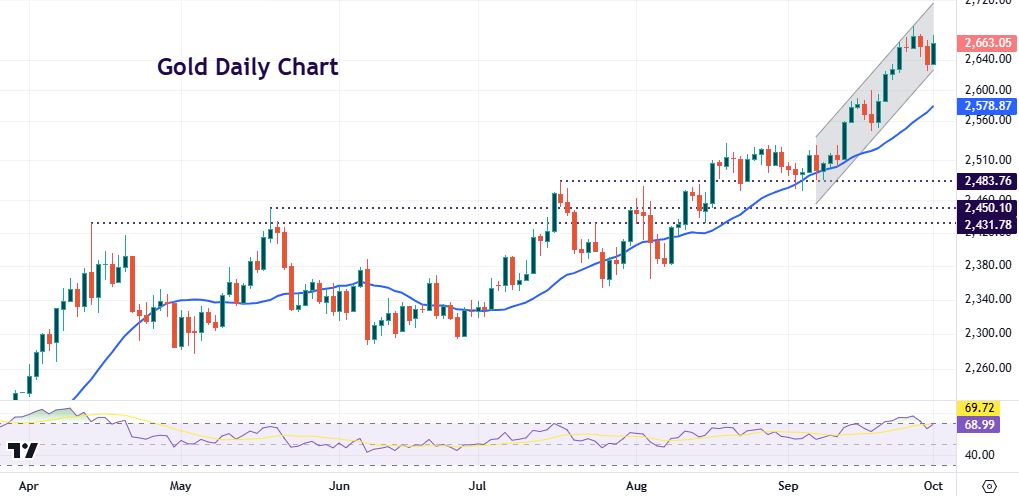Markets risk off as Iran launches missile strike, Israel vows retaliation

* Stocks drop amid growing geopolitical tensions
* Gold and oil rise as conflicts in the Middle East escalate
* Sharp drop in eurozone inflation sets up October ECB rate cut
* US JOLTS data mixed as investors await Friday’s NFP report
FX: USD saw a ‘flight to quality’ risk off move. The move took the dollar index above the 21-day SMA at 101.03 to close above there for the first time in three weeks. The buck had been on the up early on after the hawkish sounding Fed Chair Powell. But mixed US data, with encouraging jobs vacancies figures and flat ISM with lower-than-expected prices paid, played second fiddle to the Middle East tensions.
EUR tumbled for a third day with its worst session since mid-June. Flash CPI data printed lower than forecast, baking in ECB rate cut expectations later this month. EZ/US two-year spreads have widened sharply over the last two weeks. That has taken the wind out of the euro sails and reinforced the top around 1.12.
GBP sold off close to the 21-day SMA at 1.3232 before paring losses. BoE official Greene, who was a dissenter to the cut in August, noted that it was questionable how quickly progress was being made with falling prices, though they were moving in the right direction.
USD/JPY traded in a relatively narrow range with haven demand for the yen seeing it virtually flat on the day versus the dollar. After winning the leadership vote for Japan’s ruling LDP Party, new Japan PM Ishiba’s government has appeared more cautious on the economy and the need for tighter monetary policy.
AUD got hit hard on the risk off move. Firmer than expected retail sales only offered very limited support. The major still trades in the pivot zone of 0.6871/99. USD/CAD moved lower finding resistance at its 21-day SMA at 1.3539. Oil jumped up close to 4% on the escalation between Israel and Iran.
US Stocks sunk from the open as investors took flight. The S&P 500 lost 0.93% to settle at 5,709. The tech-heavy Nasdaq 100 moved 1.43% lower to finish at 19,773. It had lost as much as 2.3% earlier in the session. The Dow closed 0.41% lower at 42,157. Naturally energy was by far the biggest outperformer, with utilities and communication services also in the green. Tech tumbled over 2.6%, with real estate the next worst sector, losing 0.66%. The VIX, Wall street’s fear gauge, rose to a three-week high just below 20. That is not excessive with tensions seemingly so high. It was the biggest S&P 500 one-day point and percentage drop since early September. But the VIX says markets do not yet envision an all-out military war.
Asian stocks: Futures are in the red. Asian stocks were mixed with several markets closed, including China and Hong Kong. The ASX 200 came under pressure with tech gains trumped by losses in mining and materials. Retail sales data was mixed. The Nikkei 225 moved higher after strong selling to kick off the week. The new LDP leader Ishiba may not be as hawkish as expected, while there was a mixed Tankan report.
Gold jumped over 1% on geopolitical concerns in the Middle East. The record top is at $2685.
Day Ahead – Eurozone unemployment and US ADP
Unemployment in the eurozone has been stuck at historical lows for some time now. Economists are not expecting imminent changes, although the labour market outlook does seem to be weakening, with labour shortages becoming a bit less problematic. The previous print in July came in at 6.4%. A tight jobs market has been a concern for some policymakers, with services inflation remaining elevated. But another rate cut by the ECB in a few weeks seems nailed on.
ADP data is often seen as a forerunner to Friday’s widely watched non-farm payrolls figures. But there is typically very little correlation between the two data points. Interestingly, the JOLTS data out yesterday was hotter than expected. But the quits rate, which Powell has cited as a labour market indicator, did fall. That is consistent with other data showing workers see a less favourable jobs outlook.
Chart of the Day – Gold closes in on more fresh highs
Gold bugs continued to drive gold prices higher last month, with the precious metal up over 30% year-to-date at one point in September. The Fed’s US interest rate cut cycle, strong central bank buying, and ETF inflows have all helped. Ongoing geopolitical risks and uncertainty ahead of the US November election also saw strong haven demand.
Speculators held their biggest long position in the precious metal since March 2020. Two-year US Treasury yields, which correlate closely with the Fed Funds rate, dropped to two-year lows. Lower borrowing costs are positive for gold as it doesn’t pay interest. Most recently, an ascending channel has developed and yesterday, the Middle East tensions saw more haven buying. Last week’s record high at $2685 is in sight and waiting to be conquered.

